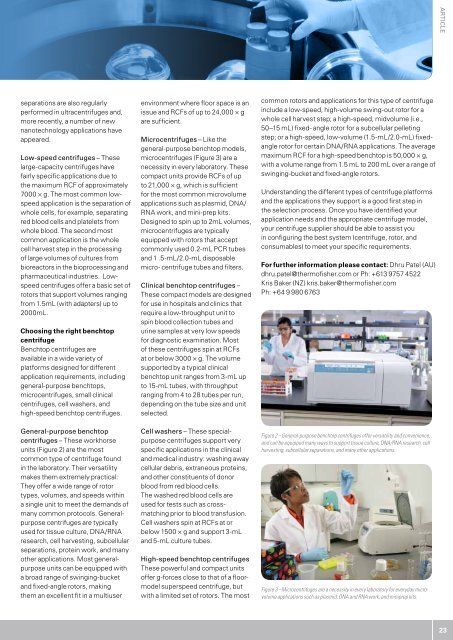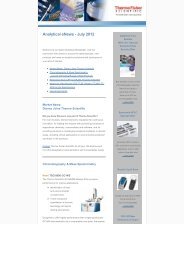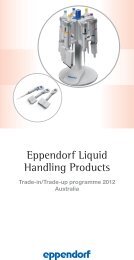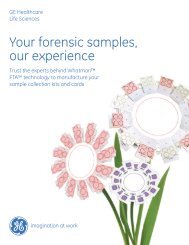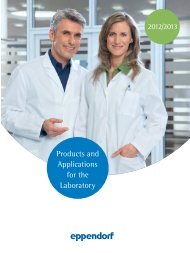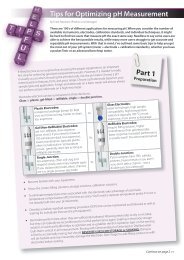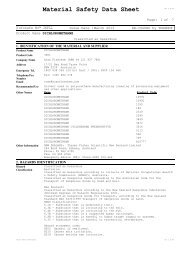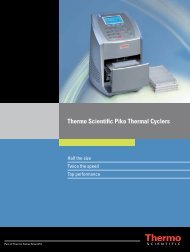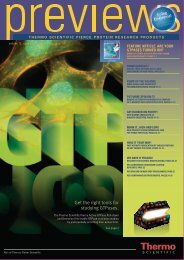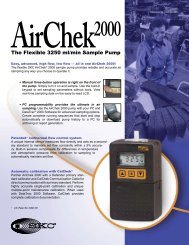Issue 1 - Thermo Fisher
Issue 1 - Thermo Fisher
Issue 1 - Thermo Fisher
Create successful ePaper yourself
Turn your PDF publications into a flip-book with our unique Google optimized e-Paper software.
Article<br />
separations are also regularly<br />
performed in ultracentrifuges and,<br />
more recently, a number of new<br />
nanotechnology applications have<br />
appeared.<br />
Low-speed centrifuges – These<br />
large-capacity centrifuges have<br />
fairly specific applications due to<br />
the maximum RCF of approximately<br />
7000 × g. The most common lowspeed<br />
application is the separation of<br />
whole cells, for example, separating<br />
red blood cells and platelets from<br />
whole blood. The second most<br />
common application is the whole<br />
cell harvest step in the processing<br />
of large volumes of cultures from<br />
bioreactors in the bioprocessing and<br />
pharmaceutical industries. Lowspeed<br />
centrifuges offer a basic set of<br />
rotors that support volumes ranging<br />
from 1.5mL (with adapters) up to<br />
2000mL.<br />
Choosing the right benchtop<br />
centrifuge<br />
Benchtop centrifuges are<br />
available in a wide variety of<br />
platforms designed for different<br />
application requirements, including<br />
general-purpose benchtops,<br />
microcentrifuges, small clinical<br />
centrifuges, cell washers, and<br />
high-speed benchtop centrifuges.<br />
General-purpose benchtop<br />
centrifuges – These workhorse<br />
units (Figure 2) are the most<br />
common type of centrifuge found<br />
in the laboratory. Their versatility<br />
makes them extremely practical:<br />
They offer a wide range of rotor<br />
types, volumes, and speeds within<br />
a single unit to meet the demands of<br />
many common protocols. Generalpurpose<br />
centrifuges are typically<br />
used for tissue culture, DNA/RNA<br />
research, cell harvesting, subcellular<br />
separations, protein work, and many<br />
other applications. Most generalpurpose<br />
units can be equipped with<br />
a broad range of swinging-bucket<br />
and fixed-angle rotors, making<br />
them an excellent fit in a multiuser<br />
environment where floor space is an<br />
issue and RCFs of up to 24,000 × g<br />
are sufficient.<br />
Microcentrifuges – Like the<br />
general-purpose benchtop models,<br />
microcentrifuges (Figure 3) are a<br />
necessity in every laboratory. These<br />
compact units provide RCFs of up<br />
to 21,000 × g, which is sufficient<br />
for the most common microvolume<br />
applications such as plasmid, DNA/<br />
RNA work, and mini-prep kits.<br />
Designed to spin up to 2mL volumes,<br />
microcentrifuges are typically<br />
equipped with rotors that accept<br />
commonly used 0.2-mL PCR tubes<br />
and 1 .5-mL/2.0-mL disposable<br />
micro- centrifuge tubes and filters.<br />
Clinical benchtop centrifuges –<br />
These compact models are designed<br />
for use in hospitals and clinics that<br />
require a low-throughput unit to<br />
spin blood collection tubes and<br />
urine samples at very low speeds<br />
for diagnostic examination. Most<br />
of these centrifuges spin at RCFs<br />
at or below 3000 × g. The volume<br />
supported by a typical clinical<br />
benchtop unit ranges from 3-mL up<br />
to 15-mL tubes, with throughput<br />
ranging from 4 to 28 tubes per run,<br />
depending on the tube size and unit<br />
selected.<br />
Cell washers – These specialpurpose<br />
centrifuges support very<br />
specific applications in the clinical<br />
and medical industry: washing away<br />
cellular debris, extraneous proteins,<br />
and other constituents of donor<br />
blood from red blood cells.<br />
The washed red blood cells are<br />
used for tests such as crossmatching<br />
prior to blood transfusion.<br />
Cell washers spin at RCFs at or<br />
below 1500 × g and support 3-mL<br />
and 5-mL culture tubes.<br />
High-speed benchtop centrifuges<br />
These powerful and compact units<br />
offer g-forces close to that of a floormodel<br />
superspeed centrifuge, but<br />
with a limited set of rotors. The most<br />
common rotors and applications for this type of centrifuge<br />
include a low-speed, high-volume swing-out rotor for a<br />
whole cell harvest step; a high-speed, midvolume (i.e.,<br />
50–15 mL) fixed- angle rotor for a subcellular pelleting<br />
step; or a high-speed, low-volume (1.5-mL/2.0-mL) fixedangle<br />
rotor for certain DNA/RNA applications. The average<br />
maximum RCF for a high-speed benchtop is 50,000 × g,<br />
with a volume range from 1.5 mL to 200 mL over a range of<br />
swinging-bucket and fixed-angle rotors.<br />
Understanding the different types of centrifuge platforms<br />
and the applications they support is a good first step in<br />
the selection process. Once you have identified your<br />
application needs and the appropriate centrifuge model,<br />
your centrifuge supplier should be able to assist you<br />
in configuring the best system (centrifuge, rotor, and<br />
consumables) to meet your specific requirements.<br />
For further information please contact: Dhru Patel (AU)<br />
dhru.patel@thermofisher.com or Ph: +613 9757 4522<br />
Kris Baker (NZ) kris.baker@thermofisher.com<br />
Ph: +64 9 980 6763<br />
Figure 2 –General-purpose benchtop centrifuges offer versatility and convenience,<br />
and can be equipped many ways to support tissue culture, DNA/RNA research, cell<br />
harvesting, subcellular separations, and many other applications.<br />
Figure 3 –Microcentrifuges are a necessity in every laboratory for everyday microvolume<br />
applications such as plasmid, DNA and RNA work, and miniprep kits.<br />
23


